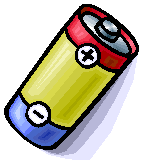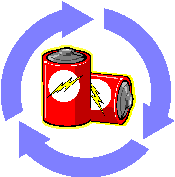Managing Household Batteries
 Household batteries, commonly known as dry cell batteries, are comprised of an anode, a cathode, and an electrolyte. The anode is the positive terminal, the cathode is the negative terminal, and the electrolyte is the chemical solution through which the electrons flow from anode to cathode, creating an electrical charge. Various metals are used in the cathodes and anodes. The following summary provides general information on the chemistry and disposal options for household batteries.
Household batteries, commonly known as dry cell batteries, are comprised of an anode, a cathode, and an electrolyte. The anode is the positive terminal, the cathode is the negative terminal, and the electrolyte is the chemical solution through which the electrons flow from anode to cathode, creating an electrical charge. Various metals are used in the cathodes and anodes. The following summary provides general information on the chemistry and disposal options for household batteries.
Nickel Cadmium Batteries
Nickel cadmium batteries consist of a nickel cathode, a cadmium anode, and an alkaline solution for an electrolyte. These batteries are rechargeable and are found in traditional cylindrical battery sizes as well as in a wide variety of battery packs. The battery packs are used in items such as cordless telephones, video cameras, hand-held vacuums, and cordless power tools. Cadmium is a toxic metal that can pose a threat to human health and the environment. Nickel cadmium batteries are labeled with the chemical symbol Ni-Cd.
Nickel cadmium batteries are a mandatory recyclable in Connecticut. Call2Recycle is an organization of battery manufacturers which has established a collection and recycling program for their nickel cadmium batteries. The program is financed by Call2Recycle. The battery manufacturers buy back the cadmium after it is processed to use in the next generation of batteries. These nickel cadmium batteries can be recycled at a number of participating retail collection points including most Radio Shack and Walmart stores. For information on where to recycle nickel cadmium batteries in your area, call 1-800-8BATTERY or log on to the Call2Recycle website at www.call2recycle.org.
Alkaline and Zinc Carbon Batteries
 Alkaline and zinc carbon batteries typically contain a manganese dioxide cathode and a zinc anode. The electrolyte in an alkaline battery is usually potassium hydroxide or sodium hydroxide, while in a zinc carbon battery the electrolyte is ammonium chloride or zinc chloride. They represent about 70% of the battery market. In the past, mercury was added to prevent corrosion and the creation of hydrogen gas. Recent laws have restricted the levels of mercury allowed in alkaline and zinc-carbon batteries. Today, alkaline batteries on the market are required to have zero-added mercury.
Alkaline and zinc carbon batteries typically contain a manganese dioxide cathode and a zinc anode. The electrolyte in an alkaline battery is usually potassium hydroxide or sodium hydroxide, while in a zinc carbon battery the electrolyte is ammonium chloride or zinc chloride. They represent about 70% of the battery market. In the past, mercury was added to prevent corrosion and the creation of hydrogen gas. Recent laws have restricted the levels of mercury allowed in alkaline and zinc-carbon batteries. Today, alkaline batteries on the market are required to have zero-added mercury.
There are limited opportunities for recycling alkaline batteries. The main barrier to the recycling of alkaline batteries has been the presence of mercury. With the advent of zero-added mercury, the economics of recycling alkaline batteries should be more favorable and we may begin to see more recycling facilities. The benefits of recycling batteries lie in the energy savings of recapturing a product compared with mining a virgin resource.
Alkaline and zinc carbon batteries can be disposed in the regular trash if there is no local recycling option available. INMETCO, a metals reclamation facility in Pennsylvania recycles alkaline and zinc carbon batteries. (724) 758-2800.
Small Sealed Lead-Acid Batteries
Small sealed lead-acid batteries are rechargeable and are used in camcorders, cordless phones, and power tools. They contain a lead dioxide or lead sulfate cathode, a lead anode and a sulfuric acid electrolyte. These small sealed lead-acid batteries can be recycled at a number of participating retail collection points including most Radio Shack and Walmart stores. For information on where to recycle small sealed lead-acid batteries in your area, call 1-800-8BATTERY or log on to the Call2Recycle website at www.call2recycle.org/.
Lithium Ion Batteries
Lithium ion batteries are rechargeable batteries most commonly found in digital cameras, cell phones and lap top computers. They contain a lithium metallic oxide as a cathode and a carbon material as an anode. The electrolyte is a lithium salt. Lithium batteries that are fully discharged are not hazardous and can safely be placed in the garbage. However, they can be recycled through the RBRC program. Call 1-800-8BATTERY or log on to the Call2Recycle website at www.call2recycle.org/.
Nickel Metal Hydride
Nickel metal hydride batteries are more environmentally friendly than nickel cadmium due to the absence of toxic cadmium. The anode is a metal alloy that absorbs hydrogen and the cathode is nickel oxide. The electrolyte is potassium hydroxide. These batteries are rechargeable and are found in camcorders, power tools, and cell phones. The have many of the same performance characteristics as nickel cadmium. They are labeled with the symbol NiMH.
Silver Oxide Batteries
Silver oxide batteries are button cells commonly used for watches, calculators, and hearing aids. They contain a zinc anode, silver oxide cathode and an alkaline solution for the electrolyte. These batteries are recyclable because of the value of the silver. Most jewelry stores will recycle the silver oxide battery when you bring your watch in to have the battery replaced.
Lithium Button Cell Batteries
Lithium batteries are button cells used primarily for cameras and contain a lithium anode and various types of cathodes and electrolytes. Lithium batteries are currently not being recycled. Lithium is a highly reactive metal and, when collected with other button cells, may present a hazard if not fully discharged. A fully discharged lithium battery converts the lithium into various lithium compounds that are inert and non-toxic. Lithium batteries do not contain mercury. If a lithium button cell is determined to be fully spent, it is safe to dispose in the regular trash.
Zinc-Air Batteries
Zinc-air batteries are button cells used primarily for hearing aids. They have a zinc anode, oxygen from the atmospheric air which acts as the cathode, and an alkaline solution as the electrolyte. There is currently limited recycling of zinc-air batteries available (INMETCO will recycle button cell batteries - 724 758-2800.)
For more information, contact Tom Metzner at (860) 424-3242 or by postal mail at:
Department of Energy and Environmental Protection
79 Elm Street
Hartford, CT 06106-5127
Content Last Updated January 2020

